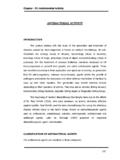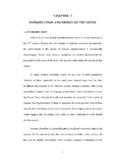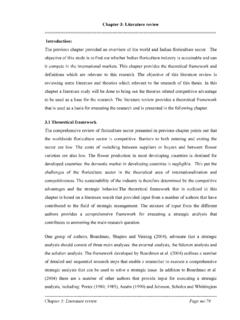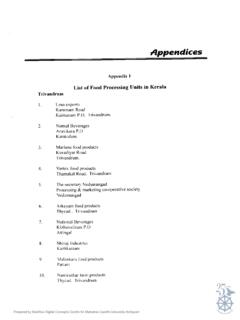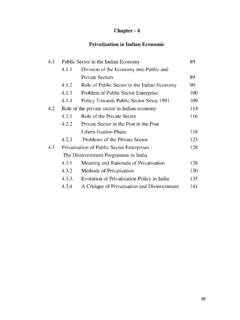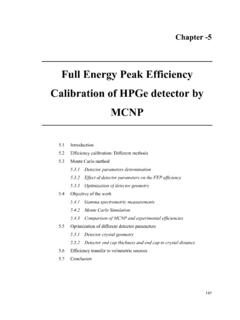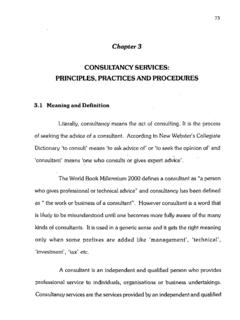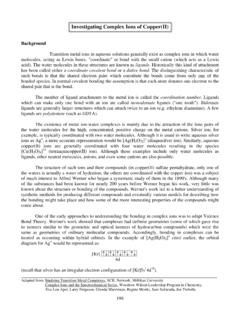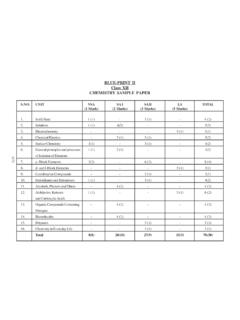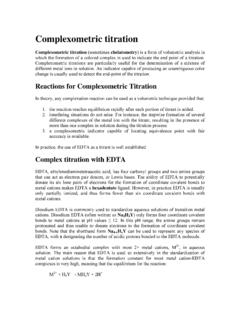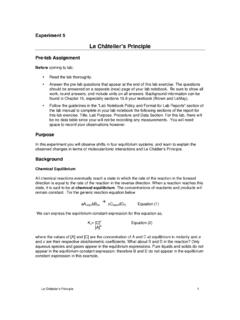Transcription of Stability constants of metal complexes - INFLIBNET
1 Stability constants of metal complexes Section - C Section C Stability constants of metal complexes Synthesis and characterization of some transition metal complexes THEORETICAL Stability of co-ordination compounds The Stability of compounds means in a most general sense, the compounds exist under suitable conditions may be stored for a long period of time. However when the formation of complexes in solution is studied, two types of stabilities, thermodynamic Stability and kinetic Stability are considered.
2 In the language of thermodynamics, the equilibrium constants of a reaction are the measure of the heat released in the reaction and entropy change during reaction. The greater amount of heat evolved in the reaction, the most stable are the reaction products. Secondly, greater the increase in entropy during the reaction, greater is the Stability of products. The kinetic Stability of complexes refers to the sped with which transformation leading to the attainment of equilibrium will occur. Here we are mainly concerned with the thermodynamic Stability of the complex compound.
3 Determination of Stability constant of complexes In complexes the term Stability is employed in two ways (1) thermodynamic Stability and kinetic Stability . Thermodynamic Stability deals with the bond energy, Stability constant and redox potential. Kinetic Stability deals with the rate of the reaction, mechanism of reaction, formation of intermediate complexes , and activation for the process etc. The thermodynamic Stability of a species is a measure of the extent to which the species will form or be transformed into other species under certain conditions, when the system has reached equilibrium.
4 Let metal ion (Mn+) combines with ligand (L) to form complex MLn, then M + nL MLn nnLMMLK Thus by knowing the value of [M], [L] and [MLn] the value of K, Stability constant of the complex MLn, can be computed. Section C Stability constants of metal complexes Synthesis and characterization of some transition metal complexes 200 The knowledge of Stability constant is needed for computing quantitatively the concentration of free metal ion, ligand and any of its complexes formed in the system, under different conditions of pH.
5 These data are extensively employed in analytical chemistry, stereochemistry, and biochemistry and in the technology of non ferrous and rare metals, solvent extraction, ion exchange etc. There are so many techniques for the computation of Stability constants . Here only two methods are explained known as pH-metric method and spectrophotometric method. Determination of stepwise Stability constants by pH-metric method As complexing processes are considered as occurring by a series of stages thus it is possible to express the formation ( Stability ) constants referring specially to the addition of ligands in a stepwise manner as follows: M + L ML LMMLK1 [ML] = K1[M][L] (a) ML + L ML2 LMLMLK22 [ML2] = K2[ML][L] (b) ML2 + L ML3 LMLMLK233 [ML3] = K3[ML2][L] (c).
6 MLn-1 + L MLn LMLMLK1nnn [MLn] = [MLn-1][L] (n) The constants K1, K2, K3,..Kn are called the stepwise Stability constants . The stepwise constants are related to the overall Stability constant by the simple related: 1 = K1 2 = 3 = 4 = Therefore n = .. Kn (1) Section C Stability constants of metal complexes Synthesis and characterization of some transition metal complexes 201A large number of techniques of great diversity are now being employed for the determination of stepwise Stability constants .
7 The most generally utilised and probably the most accurate and reliable method for the determination of Stability constant is based on the potentiometric measurement of hydrogen ion concentration. This depends on the fact that pH of the solution is directly affected by complex formation, which is accompanied by the displacement of a proton from the acidic ligand. The magnitude of the observed pH change may be employed to determine the Stability constant of the metal complexes by Bjerrum s method, Calvin and Wilson s method.
8 Out of these techniques Bjerrum s method is better as used by Calvin and Wilson. Bjerrum suggested certain formation functions such as An, n, pL. These functions are employed to calculate the stepwise Stability constans. The formation function (n) of a metal ligand (M, L) system can be defined as: MofionconcentratTotalMtoboundLofionconce ntratTotaln ..]ML[]ML[]ML[]M[..]ML[3]ML[2]ML[n3232 (2) Substitute the values of eq. (a), (b), (c) and (n) in (2) ..]L][ML[K]L][ML[K]L][M[K]M[..]L][ML[K2] L][ML[K2]L][M[Kn23212321 (3) Now substitute the value of eq.
9 (a) and (b) in (3) ..]L][ML[KK]L][M[KK]L][M[K]M[..]L][ML[KK 3]L][M[KK2]L][M[Kn23222112322211 (4) Now the value of eq. (a) substitute in (4) Section C Stability constants of metal complexes Synthesis and characterization of some transition metal complexes ]L][M[KKK]L][M[KK]L][M[K]M[..]L][M[KKK3] L][M[KK2]L][M[Kn3321221133212211 (5) Now taking [M] common form eq.
10 (5) ..]L[KKK]L[KK]L[ ]L[KKK3]L[KK2]L[Kn3321221133212211 (6) Now according to eq. (1) n = , b1 = K1, 2 = , 3 = , and so on, substitute in the (6) ..]L[]L[]L[ ]L[3]L[2]L[n3232 n0iiin0iii]L[1]L[in (7) n0iii]L[)1n(in (8) In this same way for ligand-proton (L, H) system formation function Anis defined as MtoboundnotLofionconcentratTotalLtobound HofionconcentratTotalnA ..]LH[]LH[]HL[]L[..]LH[3]LH[2]HL[n3232A ..]L[]H[KKK]L[]H[KK]L][H[K]L[..]L[]H[KKK 3]L[]H[KK2]L][H[Kn3H3H2H12H2H1H13H3H2H12 H2H1H1A Section C Stability constants of metal complexes Synthesis and characterization of some transition metal complexes ]H[KKK]H[KK]H[ ]H[KKK3]H[KK2]H[Kn3H3H2H12H2H1H13H3H2H12 H2H1H1A.
